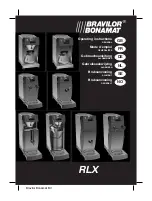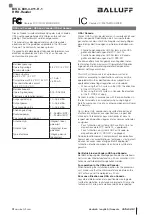
Appendix A
Specifications
A–4
RTD Accuracy and Temperature Drift Specifications
RTD Type
Accuracy
➁
(0.5 mA Excitation)
Accuracy
➁
(2.0 mA Excitation)
Temperature Drift
➅
(0.5 mA Excitation)
Temperature Drift
➅
(2.0 mA Excitation)
100
W
1.0
°
C
(
2.0
°
F)
0.5
°
C
(
0.9
°
F)
0.034
°
C/
°
C
(
0.061
°
F/
°
F)
0.014
°
C/
°
C
(
0.025
°
F/
°
F)
Platinum 385
➀
200
W
1.0
°
C
(
2.0
°
F)
0.5
°
C
(
0.9
°
F)
0.034
°
C/
°
C
(
0.061
°
F/
°
F)
0.014
°
C/
°
C
(
0.025
°
F/
°
F)
Platinum (385)
➀
500
W
0.6
°
C
(
1.1
°
F)
0.5
°
C
(
0.9
°
F)
0.017
°
C/
°
C
(
0.031
°
F/
°
F)
0.014
°
C/
°
C
(
0.025
°
F/
°
F)
1000
W
0.6
°
C
(
1.1
°
F)
0.5
°
C
(
0.9
°
F)
0.017
°
C/
°
C
(
0.031
°
F/
°
F)
0.014
°
C/
°
C
(
0.025
°
F/
°
F)
100
W
1.0
°
C
➆
(
2.0
°
F)
0.4
°
C
(
0.7
°
F)
0.034
°
C/
°
C
(
0.061
°
F/
°
F)
0.011
°
C/
°
C
(
0.020
°
F/
°
F)
Platinum 3916
➀
200
W
1.0
°
C
➆
(
2.0
°
F)
0.4
°
C
(
0.7
°
F)
0.034
°
C/
°
C
(
0.061
°
F/
°
F)
0.011
°
C/
°
C
(
0.020
°
F/
°
F)
Platinum (3916)
➀
500
W
0.5
°
C
(
0.9
°
F)
0.4
°
C
(
0.7
°
F)
0.014
°
C/
°
C
(
0.025
°
F/
°
F)
0.011
°
C/
°
C
(
0.020
°
F/
°
F)
1000
W
0.5
°
C
(
0.9
°
F)
0.4
°
C
(
0.7
°
F)
0.014
°
C/
°
C
(
0.025
°
F/
°
F)
0.011
°
C/
°
C
(
0.020
°
F/
°
F)
Copper (426)
➀➂
10
W
Not allowed.
➄
0.6
°
C
(
1.1
°
F)
Not allowed.
➄
0.017
°
C/
°
C
(
0.031
°
F/
°
F)
Nickel (618)
➀➃
120
W
0.2
°
C
(
0.4
°
F)
0.2
°
C
(
0.4
°
F)
0.008
°
C/
°
C
(
0.014
°
F/
°
F)
0.008
°
C/
°
C
(
0.014
°
F/
°
F)
Nickel (672)
➀
120
W
0.2
°
C
(
0.4
°
F)
0.2
°
C
(
0.4
°
F)
0.008
°
C/
°
C
(
0.014
°
F/
°
F)
0.008
°
C/
°
C
(
0.014
°
F/
°
F)
Nickel Iron (518)
➀
604
W
0.3
°
C
(
0.5
°
F)
0.3
°
C
(
0.5
°
F)
0.010
°
C/
°
C
(
0.018
°
F/
°
F)
0.010
°
C/
°
C
(
0.018
°
F/
°
F)
➀
The digits following the RTD type represent the temperature coefficient of resistance (
α
), which is defined as the resistance change per ohm per
°
C. For instance,
Platinum 385 refers to a platinum RTD with
α
= 0.00385 ohms/ohm –
°
C or simply 0.00385 /
°
C.
➁
The accuracy values assume that the module was calibrated within the specified temperature range of 0
°
C to 60
°
C (32
°
F to 140
°
F).
➂
Actual value at 0
°
C is 9.042
W
per SAMA standard RC21–4–1966.
➃
Actual value at 0
°
C is 100
W
per DIN standard.
➄
To maximize the relatively small RTD signal, only 2 mA excitation current is allowed.
➅
Temperature drift specifications apply to a module that has not been calibrated.
When you are using 100
W
or 200
W
platinum RTDs with 0.5 mA excitation
current, refer to the following important note about module accuracy.
Important:
Module accuracy, using 100
W
or 200
W
platinum RTDs with 0.5
mA excitation current, depends on the following criteria:
•
Module accuracy is
0.6
°
C after you apply power to the module or
perform an autocalibration at 25
°
C ambient with module operating
temperature at 25
°
C.
•
Module accuracy is
(0.6
°
C +
D
T
0.034
°
C/
°
C) after you apply
power to the module or perform an autocalibration at 25
°
C ambient with
the module operating temperature between 0
°
to 60
°
C.
–
where
D
T is the temperature difference between the actual operating
temperature of the module and 25
°
C and 0.034
°
C/
°
C is the
temperature drift shown in the table above for 100
W
or 200
W
platinum
RTDs.
•
Module accuracy is
1.0
°
C after you apply power to the module or
perform an autocalibration at 60
°
C ambient with module operating
temperature at 60
°
C.
AB Spares
Summary of Contents for SLC 500 1746-NR4
Page 1: ...User Manual SLC 500t RTD Resistance Input Module Cat No 1746 NR4 Allen Bradley AB Spares ...
Page 15: ...Preface P 8 Notes AB Spares ...
Page 37: ...Chapter 2 Quick Start 2 12 Notes AB Spares ...
Page 63: ...Chapter 4 Preliminary Operating Considerations 4 12 Notes AB Spares ...
Page 87: ...Chapter 5 Channel Configuration Data and Status 5 24 Notes AB Spares ...
Page 107: ...Chapter 7 Module Diagnostics and Troubleshooting 7 8 Notes AB Spares ...
Page 117: ...Chapter 8 Application Examples 8 10 Notes AB Spares ...
Page 123: ...Appendix A Specifications A 6 Notes AB Spares ...
Page 125: ...Appendix B RTD Standards B 2 Notes AB Spares ...














































